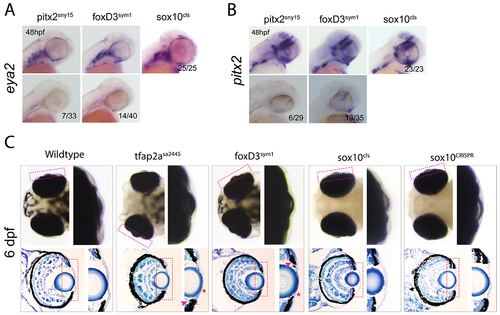Fig. 5
- ID
- ZDB-FIG-240604-5
- Publication
- Vöcking et al., 2022 - Zebrafish anterior segment mesenchyme progenitors are defined by function of tfap2a but not sox10
- Other Figures
- All Figure Page
- Back to All Figure Page
|
Anterior segment development does not require sox10 function. A) WISH detecting expression of eya2 in 48hpf embryos from in-crosses of pitx2sny15/+, foxD3sym1/+ or sox10cls/+. Proportion of embryos with corresponding expression phenotypes are displayed. Approximately 25% of embryos from pitx2sny15/+ or foxD3sym1/+ in-crosses display the absence of eya2 expression, while 100% of embryos from sox10cls/+ crosses show wildtype levels of expression at 48hpf. B) WISH detecting expression of pitx2 in 48hpf embryos from in-crosses of pitx2sny15/+, foxD3sym1/+ or sox10cls/+. Proportion of embryos with corresponding expression phenotypes are displayed. Approximately 25% of embryos from pitx2sny15/+ or foxD3sym1/+ in-crosses display the absence of pitx2 expression, while 100% of embryos from sox10cls/+ crosses show wildtype levels of expression at 48hpf. C) Whole mount dorsal images and cryosections of wildtype, tfap2asa2445/sa2445, foxD3sym1/sym1, sox10cls/cls or sox10CRISPR. Cranial structures, improperly set eyes, as well as the anterior segment (Magenta rectangle representing the enlargement) thickness and organization are malformed in tfap2asa2445/sa2445, foxD3sym1/sym1 larva but not in sox10cls/cls or sox10CRISPR. Toluidine blue staining of 6dpf old eyes reveals a thinned cornea (red *) and irregular shape of the ICA (magenta arrow) in tfap2asa2445/sa2445 and foxD3sym1/sym1 larvae, but not in sox10cls/cls or sox10CRISPR. |

